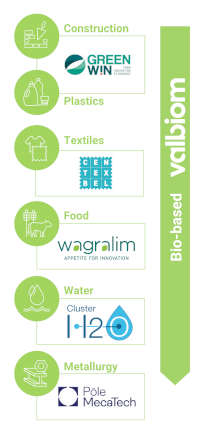The circular economy offers many opportunities for Wallonia: to gain in prosperity while addressing the societal challenges it faces, such as poverty, climate change, biodiversity loss or the depletion of natural resources.
With this in mind, on February 4, 2021, the Walloon Government adopted its first Circular Economy Deployment Strategy, Circular Wallonia.
This Strategy aims to promote and strengthen the circular economy in Wallonia, stimulating economic recovery and development, creating jobs and responding to major environmental challenges.
A Global Strategy for Wallonia
Circular Wallonia is structured around 5 action areas: the production and supply of circular goods and services, the demand and consumption of circular goods and services, the mobilization of all stakeholders, waste management, and priority value chains.
Circular Wallonia intends to coordinate, reinforce and increase the regional dynamic in circular economy. The strategy comprises 10 goals translated into 60 specific measures aimed at facilitating the circular transition of Wallonia's economic players. It is based on participative and flexible governance to ensure the effective implementation of actions.
Through its Circular Wallonia strategy, the Walloon Region is tackling today's environmental, economic and societal challenges. Against a backdrop of resource scarcity, supply risks and volatile raw material prices, it plans to move towards an economy that is:
- carbon-neutral;
- regenerative in its use of resources and through preserving biodiversity;
- resilient and inclusive;
- stimulating for innovation and digital transition.
A circular economy offers numerous opportunities for Wallonia: gaining prosperity while addressing the societal challenges it faces, such as poverty, climate change, biodiversity loss, or the depletion of natural resources.
With this in mind, the Walloon Government adopted Circular Wallonia, the first circular economy deployment strategy in the Walloon Region, on 4 February 2021.
This Strategy aims to promote and strengthen the circular economy in Wallonia, stimulating economic recovery and development, creating jobs, and addressing major environmental challenges.
6 priority value chains
In an effort to strengthen Wallonia’s competitiveness through interregional synergies and complementarities and to activate European levers, the selection of the 6 priority value chains was made at the intersection of European themes with Wallonia’s strengths and ambitions:

- Construction and buildings - coordinated by GreenWin;
- Plastics - coordinated by GreenWin;
- Textiles - coordinated by Centexbel;
- Food and food systems - coordinated by Wagralim;
- Water - coordinated by the H20 Cluster;
- Metallurgy (including rare metals and batteries) - coordinated by the Mecatech Cluster...
- ...and a transversal value chain: the biobased economy - coordinated by Valbiom.
These coordinators ensure the operationalization of actions linked to value chains, as well as leading a sector-wide network.
To go further
To learn more about the circular economy in Wallonia, explore the legislation, partners & stakeholders, inovative circular initiatives, the network of industrial symbiosis facilitators, as well as support, financing, and training mechanisms.
Evaluation of Circular Economy in Wallonia
Regular evaluations allow us to measure the impact of initiatives, optimize resources, and create sustainable jobs. Discover the results of the latest evaluations and key performance indicators to track progress towards a more circular economic model.
The Walloon Region conducted a comprehensive survey from September to November 2021 to assess the understanding of the circular economy among Walloon businesses. This study was carried out by a research firm commissioned by the SPW, interviewing a sample of 2,500 companies of all sizes and sectors by phone.
In addition to evaluating the level of knowledge, the survey aimed to identify practices in the circular economy, as well as the obstacles and needs encountered in the field for implementing this approach.
The implementation report of Circular Wallonia provides an overview of the implementation of the Walloon Circular Economy Deployment Strategy, from its approval by the Walloon Government on February 4, 2021, until December 31, 2023.
It is important to note that the Strategy is still ongoing, and another implementation report will be published to detail the continuation of actions undertaken within the framework of Circular Wallonia, starting from January 1, 2024.
- Read the Complete Report (FR)
- Read the Report Summary (FR)
- View the Synthetic brochure (FR and EN)
- View the Key-Figures (FR)
The Walloon Region launched, in 2024, a second edition of its Circular Economy Barometer to assess the knowledge and practices of companies in this area. This extensive survey was aimed at Walloon companies of all sizes and sectors.
The 2024 edition of the Barometer represents a new version compared to the 2022 edition. The statistical method and the questions sent to companies have been modified. Therefore, these two questionnaires are not comparable.
Discover the barometer results soon!

